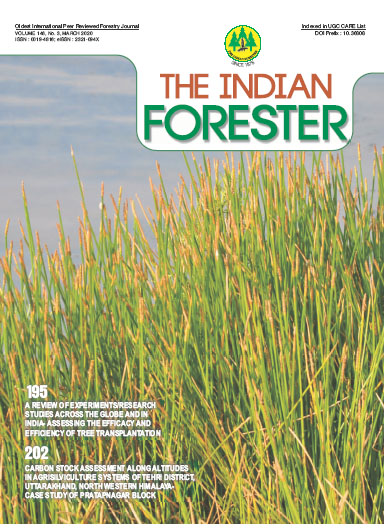Ecological Status of Angiospermic Macrophytes in Retension Ponds and Drainage Ditches of Jalpaiguri District, West Bengal, India
DOI:
https://doi.org/10.36808/if/2020/v146i3/145704Keywords:
Macrophytes, Jalpaiguri, Underutilized Aquatic Body, Fresh Water Ecosystem, Weed.Abstract
Aquatic angiosperms are very remarkable components of aquatic systems which are very important for the conservation of any biodiversity region. Though the macrophytic communities of rivers, lakes and large aquatic bodies of many biodiversity regions were recorded properly but the macrophytes of small retension pond and drainage ditches were neglected as these are underutilized aquatic bodies. The condition is also same for the district Jalpaiguri. The present study is therefore designed to enumerate the aquatic macrophytes of Retension Ponds and Drainage Ditches of Jalpaiguri District, West Bengal, India. The studies were conducted in between January 2017 to May 2019. In this study 201 angiosperms were recorded under 48 families.References
Adelakun K.M., Kehinde A.S., Amali R.P., Ogundiwin D.I. and Omotayo O.L. (2016). Nutritional and Phytochemical Quality of Some Tropical Aquatic Plants. Poultry, Fisheries and Wildlife Sciences, 4(2): 1-4.
Adigun B.A. (2005). Water Quality Management In Aquaculture and Freshwater Zooplankton. innovative Venture Press, NigerState, 1-15.
Ali N., Chaudhary B.L. and Khandelwal S.K. (2004). Better use of water hyacinth for fuel, manure and pollution free environment. Indian Journal of Environmental Protection, 24: 297-303.
Bini L.M., Oliveria L.G., Souza D.C., Cavalho P. and Pinto M.P. (2005). Patterns of the aquatic macrophytes cover in Cachoeira dourada Reservior (GO-MG). Brazilian Journal of Biology, 65(1): 19-24.
Brix H. and Schierup H.H. (1989). The use of aquatic macrophytes in waterpollution control. Ambio. 18: 100-107.
Cook CDK. (1990). Aquatic Plant Book. SBP Academic, The Hague, Netherlands. 110-112.
Deepa M., Usha P.T.A., Nair C.P. and Prasannakumari K.T. (2009). Antipyretic Antipyretic activity of seeds from Red and White type of lotus (Nelumbo nucifera) in Albino rat. Veterinary World, 2(6) 213-214.
Dienye H.E. (2015). Species Diversity of Macrophytes of the New Calabar River, Niger Delta, Nigeria, international Journal of Fisheries and Aquatic Studies, 3(1): 409-413.
Esteves F.A. (1998). Fundamentos de limnologia, Interciencia, Rio de Janaro, Brazil.
Flint N.A. and Madsen J.D. (1995). The effect of Temperature and Daylength on the Germination of Potamogeton nodosus Tubers. Journal of Freshwater Ecology, 10(2): 125-128.
Joshi S. (2018). Floristic Diversity in the Wetlands of Kota District, Rajasthan-A Surveyof Abhera Pond, international Journal of Theoretical and Applied Sciences, 10(1): 217-221.
HarborneA.J. (1984). Phytochemical Methods: A guideto modern techniques of plant analysis (2nd edn). Chapman and Hall. London.
Heywood J.H. (1978). Flowering plants ofthe world. Oxford University Press, UK.
Larson G.E. (1993). Aquatic and wetland vascular plants of the northern Great Plains. Gen. Tech. Rep. RM-238. Fort Collins, CO: U.S. Department of Agriculture, Forest Service, Rocky Mountain Forest and Range Experiment Station.
Lopes C.A., Benedito-Cecilio E. and Martinelli L.A. (2007). Variability in the carbon isotopes signature of Prochilidus lineatus (Prochilodontidae, Characiformes) a bottom-feeding fish of the Neotropical region. Journal of Fish Biology. 70: 1649-1659.
Mshandete A., Kivaisi A., Rubindamayugi M. and Mattiasson B.O. (2004). Anaerobic batch codigestion of sisal pulp and fish wastes. Bioresource Technology. 95: 19-24.
Naghma K. and Sarwat S. (2005). Anticarcinogenic effect of Nymphaea alba against oxidative damage, hyper-proliferative response and renal carcinogenesis in Wistarm rats. MolecularandCellularBiochemistry, 271: 1-11.
Okayi R.G., Chokom A.A. and Angera S.M. (2011). Aquatic Macrophytes and Water Quality Parameters of Selected FloodplainsandRiverBenue, Makurdi, Benue State, Nigeria.
Pelicice F.M., Thomas S.M. and AgostinhnoA.A. (2008). Simple relationships to predict attributes offish assemblages in patches of submerged macrophytes. Neotropical ichthyology, 6: 543-550.
PetrT. (2000). Interactions between fish and aquatic macrophytes in inland waters. A Reviewed FAO Fisheries Technical Paper No. 396 Rome.
Ratusshnyale A.A. (2008). The role ofaquatic macrophytes in hydro ecosystem of the Kuibysheu reservoir. Journal of Agriculture and Environmental Science, 4(1): 01-08.
Reddy K.R. and Sutton D.L. (1984). Water hyacinth forwater quality improvement and biomass production. Journal o f Environmental quality, 13: 1-8.
Sarkar A.K., Dey M. and Mazumder M. (2018). Impact of non-timber forest products on Forest and in Livelihood Economy of the People of Adjoining Areas ofJalpaiguri Forest Division, West Bengal, India, international Journal of Life Sciences. 6(2): 365-385.
Szczeck M.M. (1999). Suppressiveness of vermicompost against fusarium wilt of tomato. Journal ofPhytopathology [Phytopathologische Zeitschrift], 47: 155-161.
Verma S.K. (1998). Reviving Wetlands Issues and challenges. Himanshu publications, Udaipur.
Uka U.N., Mohammed H.A. and Ovie S.I. (2009). Current diversity ofaquatic macrophytes in Nigerian freshwater ecosystem. Brazilian Journal of Aquatic Science and Technology, 13: 9-15.
Wetzel R.G. (2001). Limnology.lakeandriverecosystems. Academic, San diego, California, U.S.A.
Downloads
Downloads
Published
How to Cite
Issue
Section
License
Unless otherwise stated, copyright or similar rights in all materials presented on the site, including graphical images, are owned by Indian Forester.





